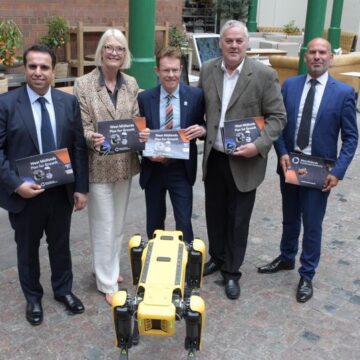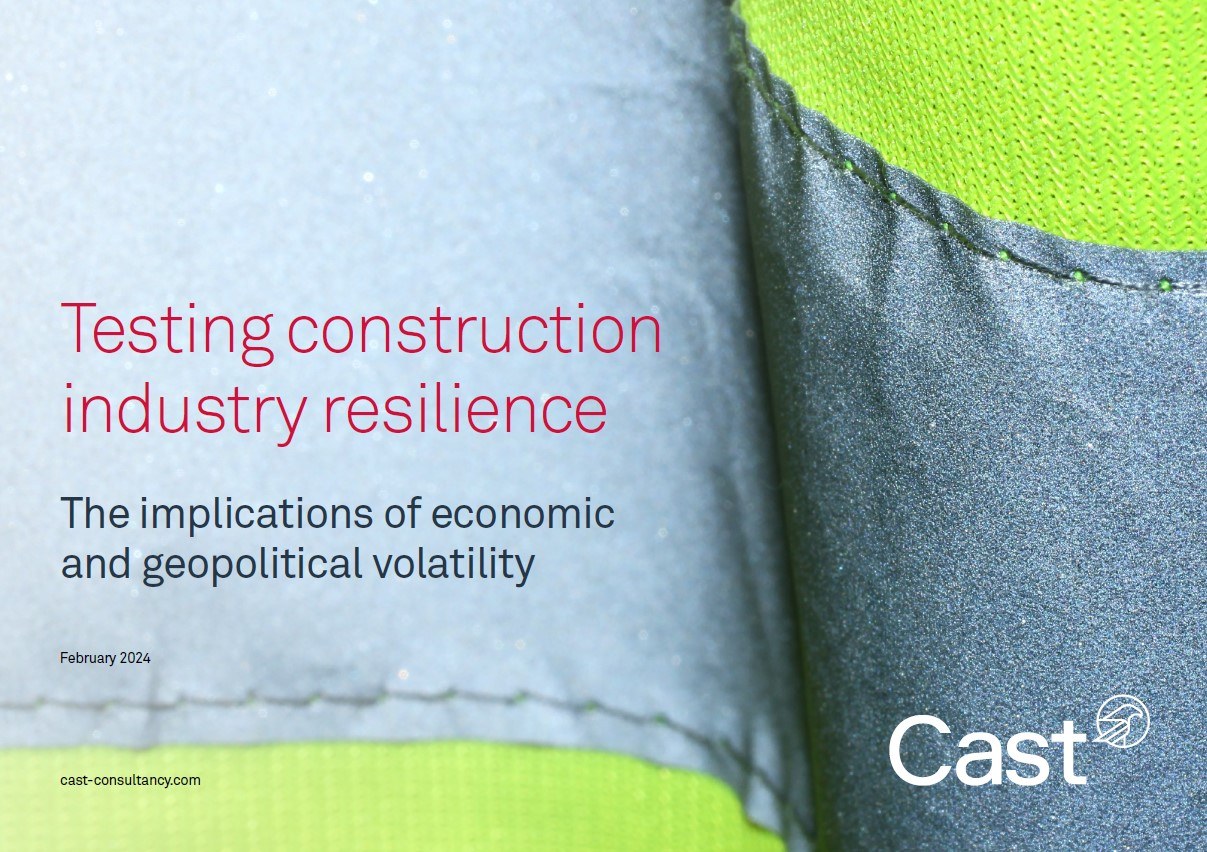Providing valuable insights into the industry, New Civil Engineers have provided a thought piece on what lies ahead for a civilisation on the cusp of change — particularly in regards to how people want to live. Within are references to Cast CEO Mark Farmer’s report Modernise or Die. Read below for the entire article.
Buildings are on the cusp of a revolution.
The way we live, work and play are changing and so too will the buildings that we use. From concerns about carbon emissions, through to an increasingly urban – and ageing – population, the challenges and opportunities facing the built environment are plentiful.
All that is required is a change in approach. So where do engineers start?
Offsite manufacturing, designing with standardised “kits of parts”, adopting new structural and façade materials along with better design for social cohesion will all play a role in delivering buildings fit for the future.
Consultant WSP’s future-ready programme leader David Symons thinks focusing on building inhabitants, rather than the design, is a good place to start.
Social Isolation
“Designing for a future of loneliness is an area we’re spending a huge amount of time thinking about,”
says Symons, by way of example. “We’re tracking that as a really important emerging trend.”
In a WSP survey, published last summer, 1,000 Londoners were asked how many neighbours they could name. The average was just 2.5. Of those living in flats, three quarters failed to name anyone in their block.
“Our research shows that it’s not just old people who suffer from loneliness. Students, particularly overseas students, young mums and disabled people are as, if not more, likely to suffer from social isolation as the old,” Symons adds.
A conservative estimate suggests that just over 1M workers experience loneliness in the UK while a study in 2007 by the New Economics Foundation estimated that in 2007 the cost of loneliness to employers through its impact on health and wellbeing was £2.5bn per year.
There is an enormous amount of work engineers can do with architects to design places that help overcome isolation.
Landscaping to encourage social interaction, benches and more common spaces in and around buildings are all simple, but important, things to incorporate into designs. Other ideas include including step-free access as standard and giving residents access to all floors not just their own to encourage interaction.
Architect Kwong Von Glinow has designed a modular building concept called the Table Top Apartments for New York’s tightly packed urban environment. It says it will create an affordable and open building aimed at encouraging social interaction.
The concept is based on the idea of stacking different shaped tables on top of each other. The result is deliberately misaligned floor slabs, with gaps and spaces between units and levels.
This channels more air and light through the building and forms balconies from which people can interact with each other.
Council on Tall Buildings and Urban Habitat (CTBUH) chair Steve Watt agrees that there is a shift to more inclusive building design.
“When you look at the London City Plan 2036, there’s an emphasis shift from London and its business credentials to people,”
says Watts. “The term mental health is in the plan several times, and how we could improve that by designing active ground plans, improving pedestrian permeability and public realm between the buildings.”
In the CTBUH’s latest annual research into tall buildings, the number of towers over 200m tall across the globe is steadily growing with over half containing a residential element. The biggest growth is in China which continues to grow its cities. It completed 25 more tall buildings than the rest of the world in 2010, and this increased to 87 last year. It also built seven out of the 10 tallest buildings completed across the globe last year. The tallest is the 527.7m high China Zun building in Beijing.
United Nations projections show that urbanisation combined with global population growth could add another 2.5bn people to urban populations by 2050, with close to 90% of the increase concentrated in Asia and Africa.
Watts says Singapore is an example of where high rise residential buildings can work. There, blocks are built with hawker centres – cheap communal eating areas – and play parks nearby. The buildings are also occupied by a wide cross-section of the population to encourage interaction between different demographics.
“Can we get to that point [where tower blocks are suitable for families] in the UK?” he asks. “I’m not sure, I think it’ll require a change in culture in this country for that to happen.
“It’s just as much about the public realm in and around the building, the amenities in the building and the way they’re used as much as the quality of the building itself.”
To help solve some of the issues concerning the lack of interaction between people in tall towers, he thinks bigger bridges will be built between buildings, increasing access to communal space and making it easier for people to connect.
Growing population density means that making sparsely available land in urban areas more productive will be increasingly important. Exploiting previously underused space, for example above railway lines and stations, is now being seriously considered.
Railway dwellings
The 16 storey, 50m tall, Biodiversity Tower in Paris is a good example of where previously overlooked land is being used to meet the meet the needs of growing urbanisation.
There, the new building, and its structural engineer Arcadis, had to overcome significant engineering challenges.
These included mitigating high flood risk from the nearby river
Seine; building close to the traffic-heavy Périphérique ring road; unfavourable ground conditions and dealing with vibrations from high speed TGV and local trains running below the site.
Despite challenges like this, the value of building social housing on previously untapped space in a congested city has been proven. Concrete slabs designed in the 1990s and 2000s now cover many of Paris’s railway lines and have enabled many large Rive Gauche developments to flourish.
In the UK, WSP has carried out its own research into building above railway tracks. It identified sufficient space associated with railway infrastructure that can yield more than 250,000 new homes in London – around five times the annual minimum needed by the capital.
Material changes
Whether building tall above railway lines or on urban land, structural concrete has been the primary material used in the construction of most of the towers built in the past year, accounting for 63% of the buildings completed globally.
Composite buildings combining structural steel and concrete was next most popular forming 35% of
the towers completed. Only one building was completed using structural steel alone.
However, cement in concrete is thought to be the source of about 8% of the world’s carbon dioxide (CO2) emissions, according to think tank Chatham House.
So with global agreements such as the Paris climate change accord putting pressure on countries to cut CO2 emissions, designers and contractors are now looking to lower the carbon footprint of tall structures, and find more sustainable construction materials.
As a result, timber is now being considered as having the potential to break boundaries in tall building construction.
Recent research by the University of Cambridge and consultant Smith & Wallwork has looked into the feasibility of building tall timber buildings delving deeper into creating new designs, rather than simply copying the forms of steel and concrete construction.
The research on a theoretical 300m tall tower highlighted areas of timber design where more research is needed before such tall structures can be built.
Perhaps the most obvious concern for potential residents of homes built primarily from timber is fire risk. But, the research shows that the proposed building “would eventually meet or exceed every existing fire regulation currently in place for steel and concrete buildings”.
Another area highlighted is that structural connections in timber buildings present more of a problem. This is because, as a building’s height increases, awkward three dimensional accumulations of forces at node points are more difficult to resolve in timber than in steel or concrete.
But Smith & Wallwork director Simon Smith says new connection designs are being developed to overcome these issues and within three to five years, he expects to see a 100m tall timber tower either on-site or completed.
To date the tallest completed, all timber tower is in Bergen, Norway. The 14 storeys residential tower is 49m tall. It will soon be overtaken by the 18 storey, 80m tall mixed-use Mjøstårnet tower under construction just north of Oslo by contractor Hent and timber subcontractor Moelven.
The team at Smith & Wallwork is now looking at designing 30 to 35 storey timber towers for which the heights are being kept under wraps.
Engineers are also developing hybrid towers – timber towers with a concrete core. An 18 storey building of this type has already been built in Canada. The Brock Commons Tallwood House is a 53m tall residential tower designed by structural engineer Fast & Epp for the University of British Columbia in Vancouver.
Although Smith is designing purely timber towers he says he has no issue with the pursuit of hybrid towers with the caveat that aspects of the design such as differing amounts of movement between concrete and timber elements over time require careful consideration.
But he says this can be overcome and a concrete core can help with egress in a fire, which can still be a sticking point with all timber buildings.
Time for offsite
Timber also lends itself well to the desire to build more offsite. This vision is shared by contractor Laing O’Rourke.
In its design for manufacture and assembly factory, it is creating a standard “kit of parts” from which buildings can be made. Using the latest manufacturing facilities and adopting lean automation processes it says it is making construction cheaper, safer and less wasteful.
“At the moment most projects are designed bespoke, from scratch, and we don’t need that every time,”
says Laing O’Rourke partnership and innovation leader Adam Locke.
“Yes they [the buildings] need to respond to the site and architectural challenge and aspiration, and be flexible, but also they don’t need to be started from scratch each time.”
Ramboll special services director, buildings Mark Pniewski agrees and says this approach does not have to result in rows of identical buildings.
“I’m a big believer in the mass customisation approach, he says. “How do you combine mass-market manufacturing with bespoke customisation, how do you reconcile the two extremes? In reality kids do it all the time with a Lego set with a standard set of components. It’s just a question of how small you go with your components.”
He says that at the moment, buildings are typically designed from the outside in, but if designers’ mindsets are changed to look at the building blocks and how they can be assembled in different and creative ways the building process will become more efficient.
“That starting point from an assembly of elements is what delivers the other benefits we’re trying to get which are cost, performance and programme certainty,” says Pniewski.
“All of these things matter to clients, and if you can build them into your design, you’re more likely to deliver on the promises you’re making.”
Delivery mechanisms must change
But Locke says to get to this point, project delivery mechanisms must change. To fully realise the benefits of manufactured buildings, he says a healthy, predictable pipeline of projects becomes critical.
Supply chain partners must also be engaged at an early stage of the design to help define to clients the cost and time savings that could be achieved by using a kit of parts approach, he says.
As it stands, only traditional building methods are presented at an early stage, and the new, more product-led approach is presented too late to allow changes to be made.
“Procurement which supports productivity efficiency and innovation is a real challenge,” says Locke. “It’s not necessarily technical, but actually it’s the thing that will create the environment for everything else to flourish.
“I think it is the mindset change around a product-led methodology rather than the way we do it today.”
In 2016, real estate and construction consultancy Cast founding partner and chief executive Mark Farmer produced a report summarising the need for more offsite construction.
The paper, Modernise or Die presented a stark wake-up call to the industry and outlined the change in mindset needed across the industry.
Farmer says over the last 10 years, attitudes towards “manufactured” buildings have shifted, and key innovations, such as a greater digital enabling of front end designs that align to the manufacturing supply chain is helping this.
As an example Tekla has developed software where detailed models can be built, analysed and sent directly to a fabricator with the “middle man” process of shop drawing creation automated.
“Rather than bespoke architect-led ‘outside in’ design, we see the advent of digital generative and intelligent design programs that can be aligned to a spectrum of manufactured products and systems,” says Farmer.
Leap of faith
Global asset manager Legal & General has taken the leap of faith in offsite modular construction.
Such is its belief in this type of construction, it has invested in building Europe’s largest modular homes factory to “deliver desirable homes through the industrialisation of volume housing supply”.
As methods become more honed, Farmer predicts that this type of construction will outperform more traditional methods of building and a larger scale operation will let the manufacturing genie out of the bottle over the next few years.
Constraints on current technology are being overcome at a frighteningly quick pace he says.
Ultimately, buildings will become digital platforms where they interact and improve themselves and learn from other buildings in the city, he adds. Predictive maintenance, air quality measurement, heating and cooling, security, lighting, ventilation, water usage will all be able to be monitored and controlled using sensors to improve the performance of the building.
To do this, a radical shift has to be made to retrofit and build technology into the concept and fabric of buildings. (See page 36 for how Siemens has transformed its Swiss headquarters into a smart hub.)
Within the build process, already the adoption of advanced forms of building information modelling, virtual reality and artificial intelligence in construction is gaining momentum.
Digital twins for buildings and cities which mirror the physical world will shape the potential for new, interdisciplinary solutions to allow the development of for more progressive and inclusive designs to be developed.
As the old adage goes, the sky(line)’s the limit.










